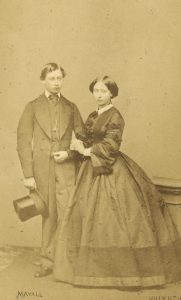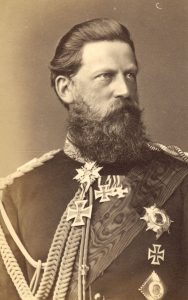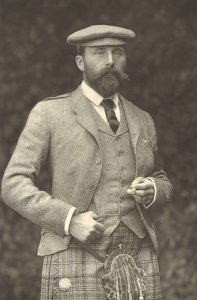[This series on royal cartes de visite began here.]
Queen Victoria and Prince Albert viewed Prussia as their ideal among the multitude of German kingdoms, principalities, and duchies. Early on in their marriage, they hoped that the son of their friends the Prince and Princess of Prussia – the former the heir presumptive to the kingdom – might someday marry their eldest daughter, Vicky, as Prince Frederick William duly did, in 1858, when the bride was just seventeen.
Fritz and Vicky were happy as a couple, but the friendly alliance of Great Britain and Prussia (from 1871 the nucleus of the German Empire) did not play out quite as the bride’s parents had expected. Instead of a liberal Germany presiding over the restless nations in eastern Europe, the British court watched in surprise as the comparatively progressive Prince of Prussia became the conservative Kaiser Wilhelm I and the once-obscure Prussian diplomat Otto von Bismarck became all-powerful at the courts of Wilhelm I (1871–88), Friedrich III (1888), and then Wilhelm II (1888–1918).
After a lengthy apprenticeship, and often in opposition to his father and Prince Bismarck, Fritz succeeded as Emperor of Germany – but only reigned for 99 days. His period as Germany’s ruler was an aside in the Wilhelmine period – Fritz’s successor would be the last German Emperor, abdicating in 1918.
The queen’s eldest daughter and son enjoyed real power, as the Empress of Germany and the King of Great Britain and Ireland. For the most part, Vicky’s younger sisters – Alice (Grand Duchess of Hesse), Helena (Princess Christian of Schleswig-Holstein), Louise (Duchess of Argyll), and Beatrice (Princess Henry of Battenberg) – found themselves in quieter waters.
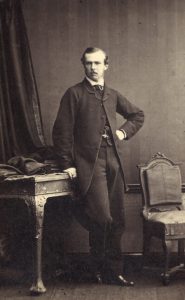 Louis IV, Grand Duke of Hesse and by Rhine (Friedrich Wilhelm Ludwig Karl, 1837–1892). CDV by Camille Silvy
Louis IV, Grand Duke of Hesse and by Rhine (Friedrich Wilhelm Ludwig Karl, 1837–1892). CDV by Camille Silvy
Hesse (one of a number of states with that name) was a pleasant place with an attractive ruling family: it had produced or would produce Empresses of Russia (Marie Alexandrovna and then Alexandra Feodorovna) as well as the cadet branch of Battenberg. A generation later, Alix, the youngest surviving daughter of Louis and Alice, the Grand Duke and Grand Duchess, would be the last Empress of Russia, perishing with her family at Yekaterinburg.
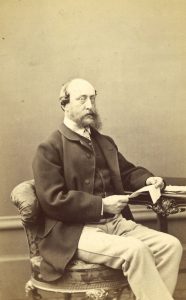 Prince Christian of Schleswig-Holstein-Sonderburg-Augustenburg (Friedrich Christian Karl August, 1831–1917). CDV by Hills & Saunders
Prince Christian of Schleswig-Holstein-Sonderburg-Augustenburg (Friedrich Christian Karl August, 1831–1917). CDV by Hills & Saunders
The “Schleswig-Holstein question” roiled European chanceries in the 1860s, and the Augustenburg branch (like the Glücksburg branch, newly ruling Denmark) lost out to Prussia in the first of the wars of unification that culminated in the Franco-Prussian War of 1870–71. Prince and Princess Christian lived for the most part in England, but in 1921 their son Albert succeeded a cousin as Duke of Schleswig-Holstein-Sonderburg-Augustenburg and thus as head of the House of Oldenburg, of which the Duke of Schleswig-Holstein-Sonderburg-Glücksburg, the Kings of Denmark, Norway, and Greece, the Grand Duke of Oldenburg, and the Russian pretender were junior members.
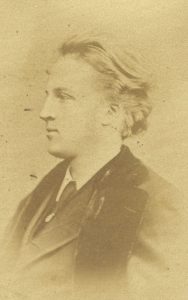 John Campbell, 9th Duke of Argyll (John George Edward Henry Douglas Sutherland Campbell, 1845–1914). CDV by Elliott & Fry
John Campbell, 9th Duke of Argyll (John George Edward Henry Douglas Sutherland Campbell, 1845–1914). CDV by Elliott & Fry
The Marquess of Lorne was an anomaly in the British royal family as the heir to a storied title and clan – but also as a subject of Queen Victoria. (Members of German royal families didn’t seem to mind marrying the subjects of other German rulers, so long as bride or groom was of “equal birth” – a subject, like the Schleswig-Holstein question, that could drive one mad.) It is said that Queen Mary, born Princess Victoria Mary of Teck and maternally the first cousin once removed of Queen Victoria, would have been unacceptable to the most minor of German princes, as her father was the offspring of a morganatic marriage – and she took her status from the Duke of Teck, not her mother Princess Mary Adelaide of Cambridge. But Princess May married her cousin George, the future King of England, with propitious results.
The marriage of Lord Lorne and Princess Louise was not especially harmonious, and would prove childless.
Here, again, one of the ubiquitous Battenbergs. Prince Henry’s brother Louis was already married to Queen Victoria’s granddaughter, and – as the Lorne marriage indicates – Victoria was less impressed by royal blood the older she got. Like Prince Christian before him, Prince Henry was an habitué of Victoria’s court; his one escape into the larger world proved fatal, as he died on a hospital ship near Sierra Leone during the Ashanti War.
Less than a decade after Prince Henry’s death, his daughter Ena (Victoria Eugenie) became Queen of Spain.
Concluded here.
Share this:
About Scott C. Steward
Scott C. Steward has been NEHGS’ Editor-in-Chief since 2013. He is the author, co-author, or editor of genealogies of the Ayer, Le Roy, Lowell, Saltonstall, Thorndike, and Winthrop families. His articles have appeared in The New England Historical and Genealogical Register, NEXUS, New England Ancestors, American Ancestors, and The Pennsylvania Genealogical Magazine, and he has written book reviews for the Register, The New York Genealogical and Biographical Record, and the National Genealogical Society Quarterly.View all posts by Scott C. Steward →
